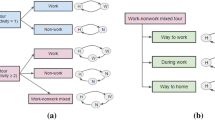Abstract
The purpose of this study is to examine the spatial and temporal characteristics of weekend work episodes. Specifically, we examine whether individuals work over the weekend and, if they work, whether they work at home or outside the home. We also model the time of day of weekend work. The empirical analysis in the paper is based on the 2000 San Francisco Bay Area Travel Survey. The results indicate the important effects of day of week/seasonal effects, individual demographics, work-related variables, household characteristics, and location variables on weekend work participation characteristics. The models estimated in the paper may be embedded within a larger weekend activity-travel pattern forecasting model system.
Similar content being viewed by others
References
Bhat, C.R.: Analysis of travel mode and departure time choice for urban shopping trips. Transport. Res. Part B 32(6), 361–371 (1998)
Bhat, C.R.: Duration modeling. Handbook of transport modelling, edited by D.A. Hensher and K.J. Button, Elsevier Science, pp. 91–111 (2000)
Bhat, C.R., Singh, S.K.: A comprehensive daily activity-travel generation model system for workers. Transport. Res. Part A 34(1), 1–22 (2000)
Bhat, C.R., Srinivasan, S.: A multidimensional mixed ordered-response model for analyzing weekend activity participation. Transport. Res. Part B 39(3), 255–278 (2005)
Damm, D.: Interdependencies in activity behavior. Transport. Res. Rec. 750, 33–40 (1980)
Fitzgerald, M.A., Winter, M.: The intrusiveness of home-based work on family life. J. Fam. Econ. Issues 22, 75–92 (2001)
Frusti, T., Bhat, C.R., Axhausen, K.W.: The spatial analysis of activity stop generation. Transport. Res. 1807, 101–108 (2003)
Hensher, D.A., Mannering, F.L.: Hazard-based duration models and their application to transport analysis. Transport Rev. 14(1), 63–82 (1994)
Kingston, P.W., Nock, S.: Consequences of the family work day. J. Marriage Fam. 47(3), 619–629 (1985)
Kinnunen, U., Mauno, S.: Antecedents and outcomes of work-family conflict among employed women and men in Finland. Hum. Relat. 52, 157–177 (1998)
Lockwood, A., Srinivasan, S., Bhat, C.R.: An exploratory analysis of weekend activity patterns in the San Francisco Bay area. Transport. Res. Rec. 1926, 70–78 (2005)
Marr, L.: Changes in ozone sensitivity to precursor emissions on diurnal, weekly, and decadal time scales. Ph.D. Thesis, Civil and Environmental Engineering, University of California, Berkeley (2002)
Mirchandani, K.: “The best of both worlds” and “Cutting my own throat”: Contradictory images of home-based work. Qual. Sociol. 23(2), 159–182 (2000)
MORPACE International, Inc., 2002. Bay area travel survey final report, March. ftp://ftp.abag.ca. gov/pub/mtc/planning/BATS/BATS2000/
Parsons Brinkerhoff Quade and Douglas, Inc.: Comparative analysis of weekday and weekend travel with NPTS integration for the RT-HIS: Regional travel-household interview survey. Prepared for the New York Metropolitan Council and the North Jersey Transportation Planning Authority, February (2000)
Pendyala, R.M., Yamamoto, T., Kitamura, R.: On the formulation of time-space prisms to model constraints on personal activity-travel engagement. Transportation 29(1), 73–94 (2002)
Pleck, J., Staines, G.: Work schedules and family life in two-earner couples. J. Fam. Issues 6, 61–82 (1985)
Presser, H.B.: Job, family, and gender: determinants of nonstandard work schedules among employed Americans in 1991. Demography 32, 577–98 (1995)
Sall, E.A.: An analysis of weekend work activity patterns. M.S. Thesis, Department of Civil Engineering, The University of Texas at Austin (2004)
Small, K.A.: A discrete choice model for ordered alternatives. Econometrica 55(2), 409–424 (1987)
Steed, J., Bhat, C.R.: On modeling the departure time choice for home-based social/recreational and shopping trips. Transport. Res. Rec. 1706, 152–159 (2000)
Strathman, J.G., Dueker, K.J., Davis, J.S.: Effects of household structure and selected travel characteristics on trip chaining. Transportation 21, 23–45 (1994)
Tausig, M., Fenwick, R.: Unbinding time: alternate work schedules and work-life balance. J. Fam. Econ. Issues 22(2), 101–119 (2001)
U.S. Census Bureau (1999) Working at home, population division, journey to work and migration statistics branch. www.census.gov/population/www/socdemo/workathome/wkhtab1.html
U.S. Department of Labor (2005) Workers on Flexible and Shift Schedules in 2004 Summary. http://www.bls.gov/news.release/flex.nr0.htm, accessed January 4, 2006
U.S. Department of Transportation (2001) National Household Transportation Survey
White, L., Keith, B.: The effect of shift work on the quality and stability of marital relations. J. Marriage Fam. 52, 453–462 (1990)
Acknowledgements
The authors would like to thank Ken Vaughn and Chuck Purvis of the Metropolitan Transportation Commission (MTC) in Oakland for providing help with data related issues. Sudeshna Sen helped with typesetting and formatting, Jamie Reckinger assisted in preliminary variable specifications, and Naveen Eluru helped in estimating the ordered generalized extreme value (OGEV) model for the work start time-of-day model. Four anonymous reviewers provided valuable comments on an earlier version of this paper.
Author information
Authors and Affiliations
Corresponding author
Rights and permissions
About this article
Cite this article
Sall, E.A., Bhat, C.R. An Analysis of Weekend Work Activity Patterns in the San Francisco Bay Area. Transportation 34, 161–175 (2007). https://doi.org/10.1007/s11116-006-0008-2
Published:
Issue Date:
DOI: https://doi.org/10.1007/s11116-006-0008-2




